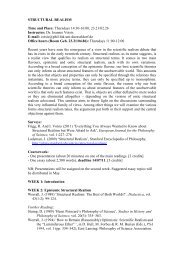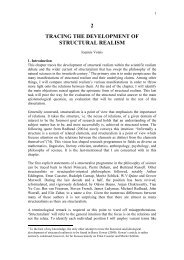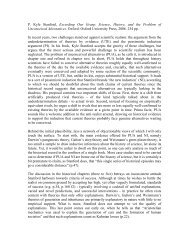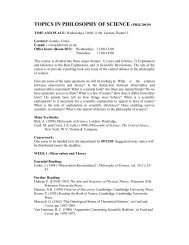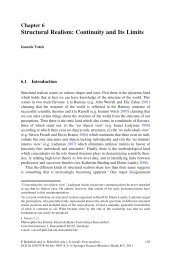Review of Anjan Chakravartty's A Metaphysics for ... - Ioannis Votsis
Review of Anjan Chakravartty's A Metaphysics for ... - Ioannis Votsis
Review of Anjan Chakravartty's A Metaphysics for ... - Ioannis Votsis
Create successful ePaper yourself
Turn your PDF publications into a flip-book with our unique Google optimized e-Paper software.
when they merely accommodate the data. To thus suggest that the existence <strong>of</strong><br />
immature sciences somehow lends credence to metaphysical speculation is selfdefeating.<br />
Indeed even the author’s conviction that metaphysical beliefs are fallible<br />
since they ‘can lose out’ (23) is tricky to maintain in the absence <strong>of</strong> an argument that<br />
real progress can be made in metaphysics - essentialism and nominalism are just two<br />
<strong>of</strong> many metaphysical theories that keep getting disinterred.<br />
What about the author’s specific metaphysical proposals, developed chiefly over<br />
chapters four to six? Chakravartty’s self-pr<strong>of</strong>essed ‘relatively modest’ and nonexclusive<br />
approach to metaphysics ring sensible at first. However, the generally<br />
unrevealing attitude towards the appropriate level <strong>of</strong> metaphysical engagement is<br />
ultimately precarious as the reader naturally wonders whether many <strong>of</strong> the details <strong>of</strong><br />
the author’s own proposals pass muster. These misgivings are not helped by the fact<br />
that some <strong>of</strong> Chakravartty’s objections have a boomerang quality. Take, <strong>for</strong> example,<br />
his dismissal <strong>of</strong> certain types <strong>of</strong> explanations about the mechanism <strong>of</strong> causation.<br />
Chakravartty carps, ‘[m]etaphors abound: links; chains; ties; glue; cement; bringing<br />
things about; and perhaps most highly scorned <strong>of</strong> all, the “powers” <strong>of</strong> ancient<br />
metaphysics’ (101). In their stead, he puts <strong>for</strong>th the view that ‘[c]ausal phenomena are<br />
produced by the ways in which property-conferred dispositions are linked to one<br />
another’ (112). How is the author’s explanation more edifying than the one citing<br />
chains, glue or cement? In what way have dispositions superceded ‘the powers <strong>of</strong><br />
ancient metaphysics’, if, by the author’s own admission (113), the explanatory benefit<br />
<strong>of</strong> dispositions can only be gleaned metaphorically?<br />
The third family <strong>of</strong> issues concerns Chakravartty’s analysis <strong>of</strong> the notion <strong>of</strong><br />
approximate truth, sketched over chapters seven and eight. The analysis is prompted<br />
by the apparent inadequacy <strong>of</strong> the existing literature to explore in-depth the notion’s<br />
qualitative, as opposed to quantitative, details. From the author’s standpoint theories<br />
deviate from the truth either by idealisation – when the postulated relations between<br />
causal properties ‘do not exist as described’ – or by abstraction – when the<br />
descriptions <strong>of</strong> postulated relations are correct but ‘applied to different circumstances’<br />
– indeed most <strong>of</strong>ten by both (147-148). Chakravartty’s call <strong>for</strong> a qualitative analysis<br />
<strong>of</strong> the notion <strong>of</strong> approximate truth would benefit from a firmer footing. At least some<br />
<strong>of</strong> his account’s presumably unique features, e.g. that more abstract theories are less<br />
approximately true than less abstract ones, drop out <strong>of</strong> the very quantitative treatments<br />
he criticises (222-223). What is more, the distinction between abstraction and<br />
idealisation cannot easily be upheld. Abstracting parameters and idealising them seem<br />
inseparable. Take the pendulum example. Removing ‘air-resistance’ is considered by<br />
Chakravartty to be an abstraction but it is also an idealisation since by abstracting we<br />
simplify the nature <strong>of</strong> the pendulum’s interactions with its surroundings. Similarly,<br />
representing the bob as a point mass is taken by the author to be an idealisation <strong>of</strong> its<br />
nature yet it is also an abstraction <strong>of</strong> a number <strong>of</strong> its features, e.g. that it has an<br />
extension, that its mass is not uni<strong>for</strong>mly distributed, etc.<br />
It is, <strong>of</strong> course, all too easy to find flaws in a book. I will there<strong>for</strong>e end this review<br />
with some notes <strong>of</strong> praise, occasions <strong>of</strong> which there are plenty. First, a testament to a<br />
selection <strong>of</strong> thoughts I found rousing. One thought, <strong>of</strong> which we admittedly get only a<br />
glimpse, fashions causation as the continuous alteration <strong>of</strong> interacting properties (§<br />
4.4). A potential upshot <strong>of</strong> this idea is a more faithful way to model dynamical<br />
systems in nature. Perhaps a more enticing thought concerns the author’s articulation



